.....When
I was learning how to play pool there were no books, no videos,
no instructors and no leagues to play in. The best way to learn
was to watch. I was privileged to see some of the greatest and
some of the not so great. My purpose for publishing my pointers
insrtuctional column is not only to inpart pool knowledge to my
viewers but to share with the public what these great players from
the 1980s and 1990s looked like. Through my trusty Canon, for a
moment in time they are immortalized. Some are still here and some
are gone and I still remember the joy of watching them play.

THE RIGHT COMBINATION
Confused and frustrated by tricky combinations?
A few helpful hints can get you back on track.
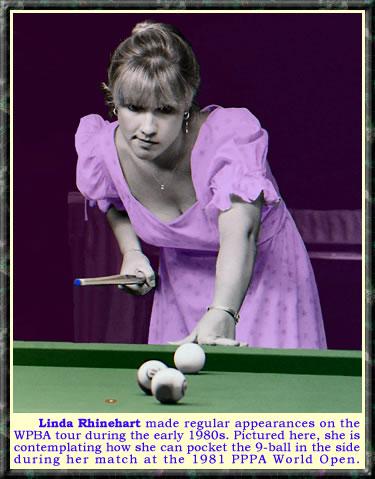
…..COMBINATIONS
ARE ALWAYS A RISK, however in some situations they are unavoidable. Linda
Rhinehart was
stumped by the pictured combination shot at the ’81 World
Open, a straight pool event. What she failed to realize was that
the 9-ball could have easily been pocketed in the side pocket.
After much deliberation, she passed on the combination and took
aim at a long cut shot into the corner pocket and missed. In reality,
all Linda was missing was a bit of information about combos.
…..Ernie
Costa, an East Coast player known for his expertise
in shooting combinations, offers a simple formula. When two object
balls are 1/3 to an 1/2 inch apart it is better to use
English to pocket the ball rather than trying to cut one ball
into the other. Apply the English (side spin) to the same side
of the cue ball that you want the second ball to travel. Use
medium speed. In this case, Linda should have put right-hand
English, at moderate speed, and aimed at the combination as if
the two object balls were going straight ahead.
…..The right-hand side spin applied to
the cue ball causes the 11 ball (the first ball) to twist to the
left which, in turn, causes the 9 ball to move right towards the
side pocket. The shot works best when the cue ball is lined up
fairly straight with the combination, but will still work from
an off angle.
…..If it is
a steeper combination and the balls are further apart, say 3/4
to one inch, apply the same English, but this time also cut the
shot slightly towards the high side of the angle. You can also
shoot the cue ball at a slower speed to get more throw into the
ball that’s
being pocketed.
…..Experiment with this formula during
practice to see just how far you can throw the combination. I
recommend that initially you use moderate speed on your stroke.
Start out using one full tip of english on the cue ball and progress
by adding ½ tip increments until you’re successful
in pocketing the combination consistently. After that you can research
with different speeds for cue ball positioning during a game. The
slower you hit the cue ball the more throw you get and the harder
you hit the less throw. Be carefully when adding speed
because there is a point wherein the combination does not throw
at all.
.....Cosmo Ransome exhibits his refereeing skills in "Don't Stand So Close To Me: Referees, The Unsung Heros of Pocket Billiards".
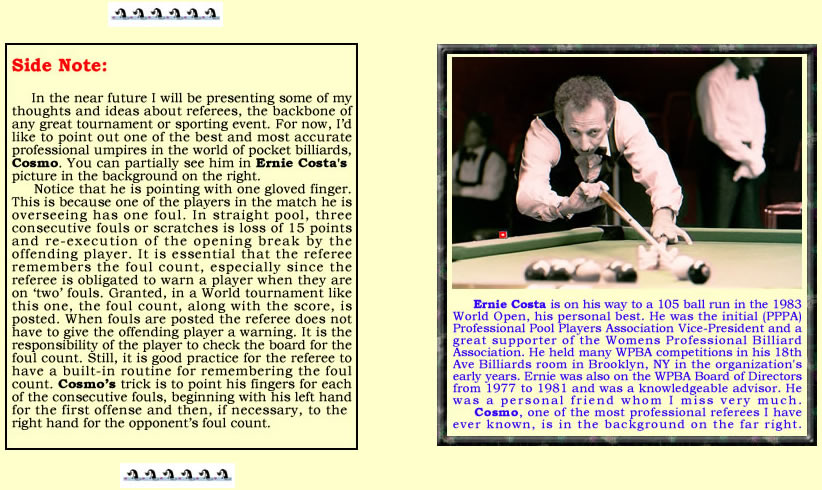
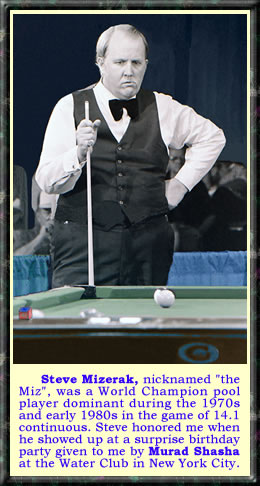 …..Be sure to look at the combination from
both sides of the lined up object balls. Here, …..Be sure to look at the combination from
both sides of the lined up object balls. Here,
Steve Mizerak checks
out a possible combination from the pocket side during the 1982
PPPA World Open. From this vantage point he figures out that the
throw required for pocketing the ball is just too much. Even with
a lot of spin and a slower speed it was unlikely the ball could
go into the corner pocket. He passes on the shot. Eventually, Steve
would go on to win this World Open event.
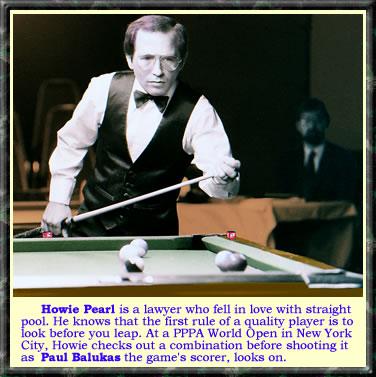
…..Howie Pearl,
an attorney, is an ardent pool player and devoted student of the
game. As a lawyer he can certainly appreciate the “laws” of
physics. I spoke with Howie after his match and he confirmed that
he used spin, one full tip of right hand english, to pocket this
particular combination. It may look, dear reader, that the pocketed
ball needed to go to the left, but if you look closely at the shot
you’ll observe
that the pocket is to the right of the
lined up balls. I recommend that you first look at the two balls
lined up straight ahead and then make your calculation.
. . . . . . . (Howie’s
wife, Linda Pearl, was a mainstay on the WPBA tour in earlier
times.)

Another
Side Note: That’s Paul Balukas in
the background of Howie’s picture. Paul served on the WPBA
Board of Directors from 1978 – 1981.
Throughout Fran Crimi’s
reign, Paul took a more active role in the workings of
the organization. Among his contributions to the billiard
community, Paul would volunteer to be a scorer at the World Open,
a much
needed component of any 14.1 tournament.
........................... ............................ ............................
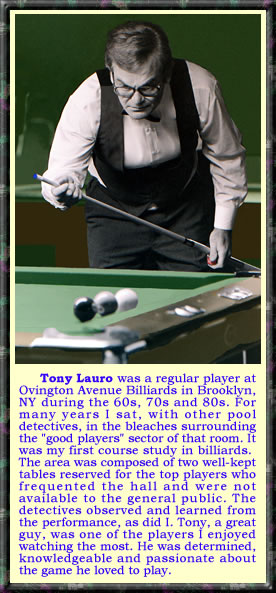
…..Tony Lauro,
is confronted with the same type of combination. The object balls
are about ½” apart.
What’s interesting about this combination is that the balls
are lined up to the right, pointing away from the pocket, and they
are very close to the corner. That translates into a bigger cut
shot requiring a lot more english than normal. In this example,
Tony has to figure out if there is enough distance on the court
for the english to take hold. Tournament cloth is always faster
and slicker than cloth in a pool room. Not only is it the highest
grade material, there is less traffic on it. Thus, the increase
in english could make the object ball being struck skid. As I suspected,
Tony told me after the game that he did not use spin to pocket
the combination. He figured out the cut and struck center on the
cue ball to make the shot. He admitted it was more difficult to
make the shot in this fashion and he had to take the equipment
into account.
…..This is another illustration
of why this game holds so many people in it’s grip. The fact that you must figure
out all the aspects of a situation before deciding how to handle
it is fascinating. It’s one of the joys of playing the game
and why I personally object to the shot clock imposed on today’s
players. But, I digress…
…..If you want to be an accomplished
player, you must take the type of equipment you’re using
into consideration. Faster cloth, like Simonis, results in more
throw while a slower cloth may require a lot more English, perhaps
as much as two full tips. Also, the better grades of object balls
work better for executing the shot and take less spin. Keep in
mind that at times the equipment will work against your using side
spin to execute a shot so you must shoot it like a normal combo.
Yet this formula for pocketing combinations with spin works well
in most situations. Like always, experimentation and practice are
the road to success.
 . .

.....Pool Pointer Archives
.....1. Closed
Half-Bridge
... .2. Look
Before You Leap
.....3. Mechanically
Inclined
.....4. Keep
a Level Cue
.....5. Double
or Nothing
.....6. Chalk
It Up
.....7. V-Bridge It To Victory
.....8. The Right Combination
.....Tune in for more Pointer articles coming
your way each month..

|

